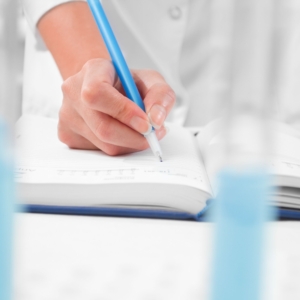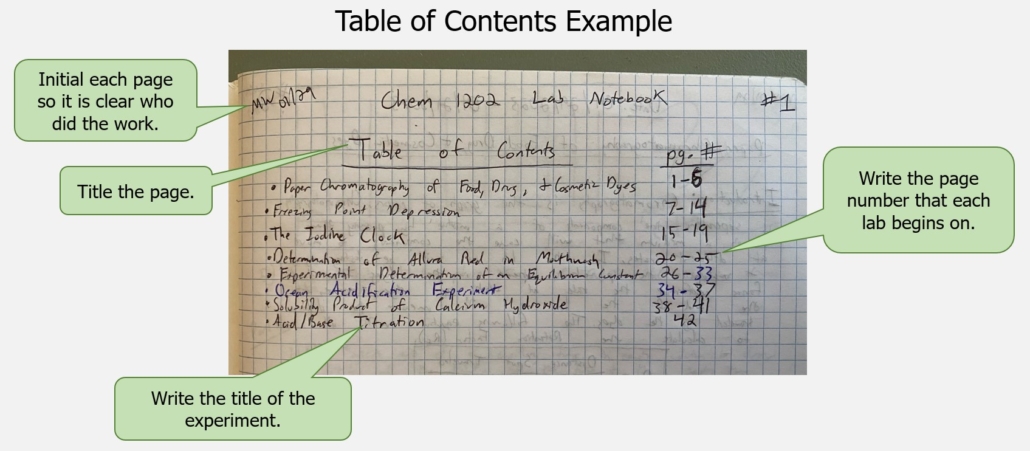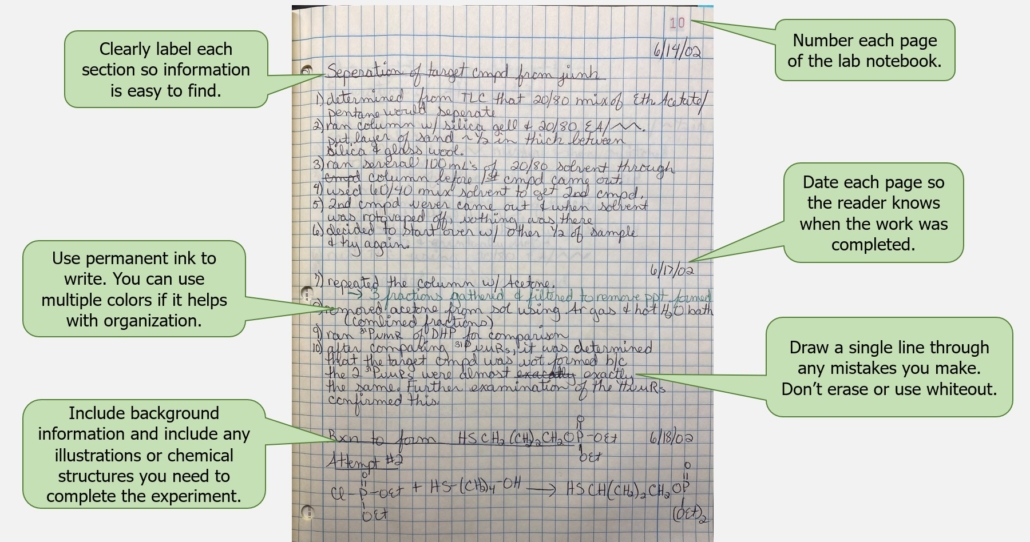Objectives
- Perform an in-depth analysis of a laboratory experiment, including statistical and graphical analysis.
- Communicate lab procedures, observations, and results in the form of a laboratory notebook, written reports, and verbal presentations effectively.
- Interpret and analyze qualitative observations and quantitative results, incorporating graphs and tables as appropriate.
- Discuss the results of the experiments in oral and written formats, including predictions, graphs, and calculations.
- Explain sources of error in experimental analysis.
Introduction
A laboratory notebook provides a singular place for scientists to record information regarding their research. A laboratory notebook completely and concisely records all of the experiments conducted and data collected in the laboratory in a manner in which any other scientist could read, understand, and reproduce the experiments contained in the notebook’s pages. In addition, laboratory notebooks include detailed descriptions of the experimental procedures they have performed, observations, results, printouts of graphs and data from instruments, diagrams of equipment setups used, and other notes relevant to their research. Typically, laboratory notebooks are permanently bound and often contain carbon paper, creating copies of everything written in the notebook.
Researchers use the information recorded in their laboratory notebooks to write their thesis or research papers for publications, as a record for submission of patents, and to enable other scientists to continue or reproduce their procedures and findings. Typically, these notebooks stay in the laboratory. However, if the research conducted is for a corporation or organization, the laboratory notebook is their property, not the researcher’s property. Some laboratories also require the researcher to make backup copies of their research daily to ensure their work isn’t lost, stolen, or destroyed.
In this course, you will keep a laboratory notebook. Below is an outline of the rules for keeping a laboratory and what information to record in it.
Laboratory Notebook Guidelines
- Your laboratory notebook should not be a spiral notebook or made of loose-leaf paper. It should be bound in a manner that does not allow the removal of pages. A composition notebook or notebook with a glued spine (no perforated pages, please) will suit this course.
- Write all entries in a water-insoluble pen such as a Sharpe pen or other permanent medium.
- All writing needs to be neat and easy to read/understand.
- Write your full name, the course title, and the first and last entry date on the front cover.
- On the inside front cover, print your full name, the course title, and your address and phone number. This way, your notebook can be returned to you if it is ever lost.
- The first couple of pages should be blank for a table of contents. You will add to the table of contents as you add to your lab notebook.
- Each page needs to be numbered, signed (signature or initials), and dated by the researcher.
- Each lab should be clearly titled. Record the title of each experiment and the page number it begins on the Table of Contents. Figure 1.0 (below) demonstrates how to set up a table of contents.
Figure 1.0 – Example of a Table of Contents
- Each section of the laboratory experiment should be labeled appropriately (i.e., safety procedures, experimental procedure, results, observations, etc.), and all relevant information should be recorded in the appropriate section.
- Write the experimental procedure thoroughly enough in your lab manual that you or anyone else can conduct the week’s activity solely from your laboratory manual.
- Accurately record all data (including units), observations, thoughts, explanations of observations, and conclusions from the week’s experiment. It is better to include too much detail than not enough. You never know what information might be helpful later when writing a paper.
- Complete any calculations for the day’s laboratory activity in your notebook. Keep them neat and organized so anyone can follow them.
- Any photographs, data printouts, graphs, etc., should be glued into the notebook to prevent them from being torn or lost.
- Record any vital safety information regarding handling chemicals or laboratory equipment before conducting any experiments.
- Reference any experimental procedure you are using that is not of your development. Also, reference any literature you have reviewed that applies to your research.
- If you make a mistake in your notes, indicate it by drawing a single line through the portion you wish to mark as incorrect. Example: The solution turned blue purple after adding acid.
- Draw a line through any empty space at the end of a page. Be sure to initial and date this to indicate this space should be blank.
- Include any notes regarding difficulties you experienced or errors you observed while experimenting.
Figure 2.0 (below) illustrates some qualities of a well-kept laboratory notebook.
Figure 2.0 – Example of how to keep a lab notebook.
Laboratory Notebook Don’ts
- Never tear pages out of your laboratory notebook.
- Never scribble anything out or use whiteout in your notebook.
- Never record anything in pencil, erasable pen, or ink that will be damaged if water or solvent spills on your notebook.
- Never write anything in your laboratory notebook that is not directly related to the experiment.
- Never record any false information in your laboratory notebook, including altering results or observations to make the experiment appear successful.
- Never record information elsewhere and then transfer it to your notebook. NO POST-ITS!
- Never re-write the information recorded in your laboratory notebook to make it look “neater.”
- Do not tape or staple anything into your lab notebook. Always use glue to affix items in a laboratory notebook permanently.
- Never skip any pages in your laboratory notebook.
Sections In a Laboratory Notebook
Include the following sections in your laboratory notebook. Before lab, you must complete the Introduction, Materials and Equipment, and Experimental Procedures sections. Each week, your instructor will check your laboratory notebook to ensure you have prepared for the week’s experiment. If you have not completed the work necessary for the experiment for that week, you cannot complete the experiment and receive a zero for that week’s lab. In addition, you cannot use any handouts or the lab manual during laboratory activities.
The Results and Observation section is completed during the lab experiment.
The Discussion and Conclusion section is completed after the experiment is over. References may be recorded before, during, and after an experiment is complete.
The information you include in your lab notebook should be clear and complete enough that anyone could pick up your lab notebook, understand your notes, follow your data and calculations, and reproduce your experiment using just what you recorded.
Everything in your lab notebook must be handwritten. You cannot print the experimental procedure and paste it into your lab notebook. The only things that you can print and paste in your lab notebook are images of chemical structure and figures provided in the information for an experiment, or graphs you have completed using Excel for the lab.
Introduction
This includes a brief description of the experiment or procedure for the lab. You may include safety information, chemical structures and reactions, constants and formulas, or any other background information to help you complete the lab. Think of this as a background reference section of the experiment.
Materials and Equipment
This includes a list of chemicals and equipment required for the experiment and calculations for preparing any solutions needed (complete with units). Be sure to include any vital chemical or equipment safety information in this section.
Experimental Procedure
This section includes the step-by-step experimental procedure. This may include of diagrams for equipment setup or supplemental information for performing specific portions of the experiment. The experimental procedure should be complete enough to conduct the experiment only using your notebook.
You may paste images of chemical reactions or equipment setup for your experimental procedure; however, the step-by-step procedure must be handwritten for this course.
Results and Observations
This section includes the data obtained during the experiment and its analysis. Show all pertinent calculations complete with units. The experimental data is often summarized in a table. You can either create your data table before you come the lab or while you are completing your experiment.
Observations can also consist of a series of notes collected during the experiment – the formation of a precipitate, a change in color of a solution, etc. Be sure to note which step of the experiment was observed so it is easier to follow your notes.
Discussion and Conclusions
This section includes a summary of the results of the lab session and what they mean. Explain this information clearly and thoroughly, tying the results to the concept discussed in the experiment.
Be sure to note any sources of error you observed during your experiment and how these have impacted your results. If you created a graph of your results, it should be glued in this section of your notebook.
References
Always cite any sources you used for each experiment. Anything you referenced or copied must be referenced at the end of each lab. This includes any experimental procedure information you didn’t expressly develop yourself.
Keeping a neat, organized lab notebook isn’t hard if you know and follow these guidelines.
References
Ellis, M. (2023). How to Make a Table of Contents, With Examples. Grammarly. https://www.grammarly.com/blog/academic-writing/table-of-contents/
Thomson JA. (2007). How to Start—and Keep—a Laboratory Notebook: Policy and Practical Guidelines. In Intellectual Property Management in Health and Agricultural Innovation: A Handbook of Best Practices (eds. A Krattiger, RT Mahoney, L Nelsen, et al.). MIHR: Oxford, U.K., and PIPRA: Davis, U.S.A. Available online at www.ipHandbook.org.
Purrington, C. Maintaining a Laboratory Notebook. Retrieved November 30, 2011 from http://colinpurrington.com/tips/academic/labnotebooks
This page was published on January 2, 2024, last updated on January 13, 2025.
©Catherine Haslag 2025. All Rights Reserved.





